
West Somerset was a local government district in the English county of Somerset. The council covered a largely rural area, with a population of 34,900 in an area of 740 square kilometres (290 sq mi); it was the least populous non-unitary district in England. According to figures released by the Office for National Statistics in 2009, the population of West Somerset has the oldest average age in the United Kingdom at 52. The largest centres of population are the coastal towns of Minehead and Watchet (4,400).
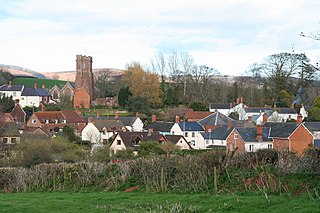
Stogumber is a village and civil parish in Somerset, England, on the eastern flank of the Brendon Hills. Besides Stogumber village itself, the parish includes the hamlets of Ashbeer, Capton, Escott, Higher Vexford, Kingswood, Lower Vellow, Lower Vexford, Preston, and Vellow. The village is on the route of the Samaritans Way South West.

Crowcombe is a village and civil parish under the Quantock Hills in Somerset, England, 5.5 miles (9 km) southeast of Watchet, and 8 miles (13 km) from Taunton. The village has a population of 489.

The Grade I listed buildings in Somerset, England, demonstrate the history and diversity of its architecture. The ceremonial county of Somerset consists of a non-metropolitan county, administered by Somerset County Council, which is divided into five districts, and two unitary authorities. The districts of Somerset are West Somerset, South Somerset, Taunton Deane, Mendip and Sedgemoor. The two administratively independent unitary authorities, which were established on 1 April 1996 following the breakup of the county of Avon, are North Somerset and Bath and North East Somerset. These unitary authorities include areas that were once part of Somerset before the creation of Avon in 1974.

The Church of St George in Bicknoller, Somerset, England dates from the 12th century and has been designated as a Grade I listed building.

The Church of All Saints in Monksilver, Somerset, England dates from the 12th century and has been designated by English Heritage as a Grade I listed building. The church has a square west tower, built in the 14th century,

The Church of the Holy Ghost in Crowcombe, Somerset, England has a tower dating from the 14th century with the rest of the building being dated at the 15th century. It has been designated by Historic England as a Grade I listed building.

The Church of St Mary the Virgin in Nettlecombe, Somerset, England dates from the 13th and 14th centuries, and has been designated as a Grade I listed building.
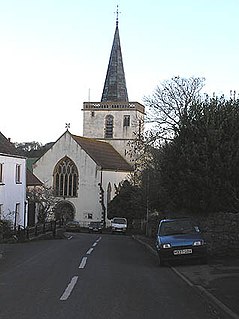
The Church of St Andrew in Stogursey, Somerset, England dates from the early 12th century and has been designated as a Grade I listed building.

The Church of St Mary in Kingston St Mary, Somerset, England, dates from the 13th century and has been designated as a Grade I listed building.

The Church of St Augustine in West Monkton, Somerset, England, dates from the 13th century and has been designated as a Grade I listed building.
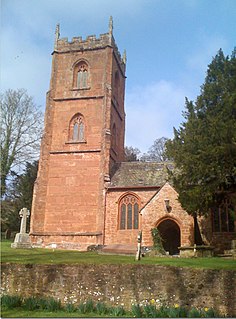
The Church of St Peter & St Paul in Combe Florey, Somerset, England has some remains from the 13th century but is mostly from the 15th century and is designated as a Grade I listed building.
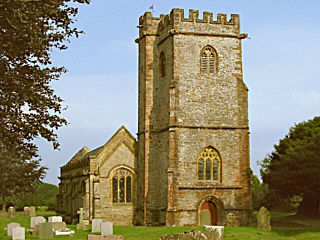
The Church of St Mary & All Saints in Broomfield, Somerset, England was built in the 15th and 16th centuries and has been designated as a Grade I listed building.

The Church of St Mary is the parish church of Cannington, Somerset, England. The parish is in the Church of England Diocese of Bath and Wells.
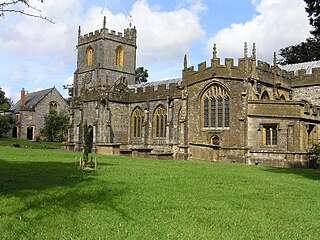
The Anglican Church of St Mary the Virgin in Chard, Somerset, England dates from the late 11th century and was rebuilt in the 15th century. It has been designated as a Grade I listed building. Due to the effects of a leak in the roof it was added to the Heritage at Risk Register in 2013.

The Church of St Mary in Mudford, Somerset, England dates from the 14th century and has been designated as a Grade I listed building.

The Church of St Mary the Virgin in Norton Sub Hamdon, Somerset, England has 13th-century origins but was rebuilt around 1510. It has been designated as a Grade I listed building.

The Anglican St Mary's Church at Stringston in the English county of Somerset dates from the 17th century. It has been designated as a Grade II listed building.
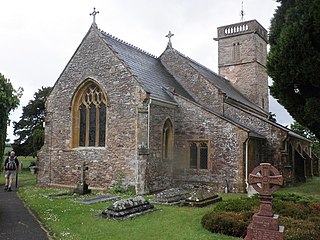
The Anglican Church of St Mary in Cheddon Fitzpaine, Somerset, England was built in the late 13th century. It is a Grade II* listed building.

The Anglican Church of St George in Sampford Brett, Somerset, England was built around 1300. It is a Grade II* listed building.




















